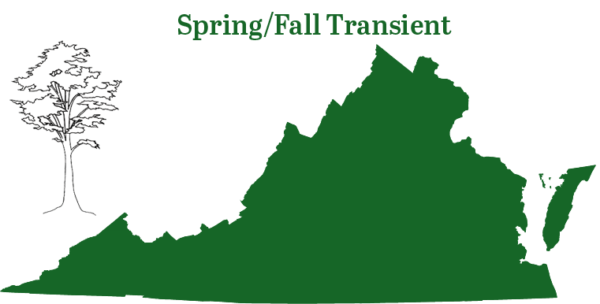Fact File
Scientific Name: Lasionycteris noctivagans
Classification: Mammal, Order Chiroptera
Conservation Status:
- Species of Greatest Conservation Need-Tier 4a on the Virginia Wildlife Action Plan
Identifying Characteristics
With dark brown to black hairs tipped in silver or white, no other bat in Virginia looks like the silver-haired. The fur extends about halfway onto the tail membrane but is not found on the shoulders or wings. Adults measure approximately 3.6–4.0 inches in length and weigh 0.3–0.4 ounces. The ears are short and rounded with the tragus being broad and blunt.
Habitat
The silver-haired bat is a tree bat that uses cavities, sloughing bark, and rock crevices for roosting. Typically, the silver-haired bat is a solitary bat, but females will form small maternity colonies. This is a bat of waterways, flying along forested riparian areas bordering streams and lakes.
Diet
The silver-haired bat is a slow yet highly maneuverable flyer and is considered an opportunistic feeder. Of the few studies conducted, moths, hoppers, long-horned bugs, beetles, and flies have been identified as prey.
Distribution:
The silver-haired bat is found throughout most of North America and just into northern Mexico. In Virginia, most records for the silver-haired bat are from spring and fall migration, but there are several records of adult males during the summer months. Females spend the summer in the northern United States and Canada where they raise their young.

Reproduction
Mating probably starts in late August with the onset of migration and continues onto the wintering grounds. Like the other tree bats, the silver-haired bat typically has two young. Gestation is about 50 to 60 days, and young are born in late June or early July and fly at about one month of age.
Conservation
Wind energy development is the primary threat to this species. Wind turbine operational adjustments or development of acoustic deterrents are conservation priorities.
Last updated: January 19, 2024
ShopDWR
Order your copy of A Guide to the Bats of Virginia, along with more gear, guides, and gifts!
Visit ShopDWRThe Virginia Department of Wildlife Resources Species Profile Database serves as a repository of information for Virginia’s fish and wildlife species. The database is managed and curated by the Wildlife Information and Environmental Services (WIES) program. Species profile data, distribution information, and photography is generated by the Virginia Department of Wildlife Resources, State and Federal agencies, Collection Permittees, and other trusted partners. This product is not suitable for legal, engineering, or surveying use. The Virginia Department of Wildlife Resources does not accept responsibility for any missing data, inaccuracies, or other errors which may exist. In accordance with the terms of service for this product, you agree to this disclaimer.

